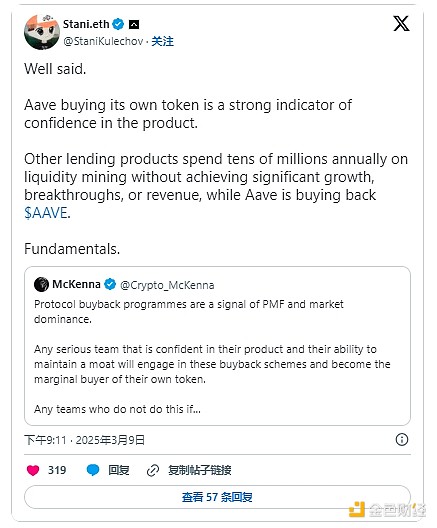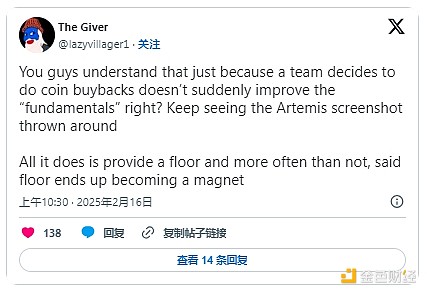Bankless: Does token repurchase make sense?

Reprinted from jinse
03/13/2025·1MAuthor: David C, Bankless; Translated by: Deng Tong, Golden Finance
Aave recently announced a new token economics reform featuring repurchases, and it is not the only project to take this move.
Since Trump won the election, more and more crypto projects have introduced token economics reforms, whether through revenue sharing or repurchase, which they believe is more suitable for such experiments. Arbitrum Arbitrum is another well-known company that adopts a buyback program, which shows that they will turn to implementing TradFi technology as crypto projects try to increase profits and better control the token supply.
With the implementation of these token economic reforms, discussions broke out on X about whether buybacks are the right way to strengthen digital assets. Opponents believe that buybacks and destruction are limited solutions for TradFi’s outdated, while proponents touted it as a direct manifestation of product market fit and market dominance.
Below, we will explore both sides of the debate, consider applying TradFi practices to our emerging markets, and highlight some alternatives to token repurchase.
Token repurchase cases
Many protocols and users view repos as direct signals of long-term consistency, revenue stability, and growth potential, so let’s look at the main arguments that support this practice.
Confidence in product market fit
Those who support token buybacks believe that these plans reflect commitments to sustainability and revenue growth. By buying back the tokens, the team demonstrates confidence in the moat and long-term prospects of its protocol, which can enhance market confidence and position the protocol as the main owner of its tokens, potentially giving it more control over the price dynamics.
Repurchases are particularly praised when the agreement is already profitable: Aave’s decision to use part of its revenue to buy its own tokens is widely seen as a decisive display of strength, in contrast, competitors invest heavily in liquidity mining, which often creates high inflation in the tokens of the agreement and is often only available to moderate adoption. In fact, why would you do this if your favorite protocol doesn't buy your own tokens?

Fundamental season
The buyback program can fit perfectly with a broader fundamental shift. In the past year, especially in the current market downturn, more and more investors have tended to have agreements with real income and stable liquidity. Repurchases can support this “fundamental season” claim by reducing circulating supply and indicating stable returns. However, this perception will only really emerge when the agreement achieves a considerable revenue, which makes Aave’s decision more attractive than Arbitrum’s decision.
The argument against repurchase
On the other hand, repurchase critics believe that the mechanism is just a "surface article" and can only create exit liquidity for major shareholders, while other strategies can better achieve the same goal.
Investment expansion
Critics argue that using treasury funds for repurchases will diversify capital for more productive pursuits—expanding product supply, increasing liquidity for different assets (i.e. buying $BTC instead of native tokens), allocating treasury assets to DeFi for high returns or building strategic partnerships. These initiatives are often seen as bringing more tangible long-term benefits that can enhance the market position of the agreement and provide a stronger foundation for it to “buy back” or to improve its token economics in the future.
Cryptocurrency is not traditional finance
While buybacks are common in the stock market—companies often use extra cash or cheap debt to buy undervalued stocks—there are different dynamics in cryptocurrency projects.
Tokens are often locked by founders and early investors, so the buyback may eventually absorb the tokens while insiders cash out, bringing their impact back to zero. Furthermore, the ongoing attribution of tokens may weaken the impact of any repo, and major announcements about token repos can sometimes simply signal sell-off points to insiders, providing tiny value for long-term holders.

Better alternatives exist
Some opponents suggest bypassing open market repurchases altogether and seeking other mechanisms to increase the price of tokens.
-
Purchase Unattended Supply: CT anon Giver recommends using Treasury funds to buy unattended distributions from early investors and then remove these tokens from circulation. This strategy will mitigate insider trading in the open market and reduce overall attributable supply in one fell swoop. Investors will receive returns, and the open market will be protected from its prices.
-
veTokenomics: Others, such as fiddy (a researcher at Lido Lido Finance, who once worked in Curve Finance), advocates token locking mechanisms, such as veModel, which rewards users with locking tokens to establish long-term governance and liquidity. However, when looking at the price performance of veTokens such as $CRV or $CVX, the results for the system are mixed.
When does a repurchase make sense
Overall, through these analyses of the pros and cons of repos, we can clearly see when repos can become part of protocol token economics. When the entire token supply is in circulation or fully attributable, repurchases can play a role similar to equity repurchases, striving to set a bottom line for prices and accumulating “undervalued” shares. Through this framework, projects like Jupiter and Hyperliquid Hyperliquid have unique advantages due to the lack of external funds, which means they have no VC-attributed tokens to be unlocked. Therefore, they implement repurchases have different meanings given the control of supply and market maturity of these projects.
Meanwhile, once the project has established a solid competitive advantage and covered growth channels—expanding product lines or exploring new markets—regulated buybacks can become a way to return capital to token holders. If the timing is properly grasped and not prematurely occurs, it can strengthen market confidence and consolidate the agreement's position (if it has enough revenue and dominance to develop an influential buyback plan).


 panewslab
panewslab